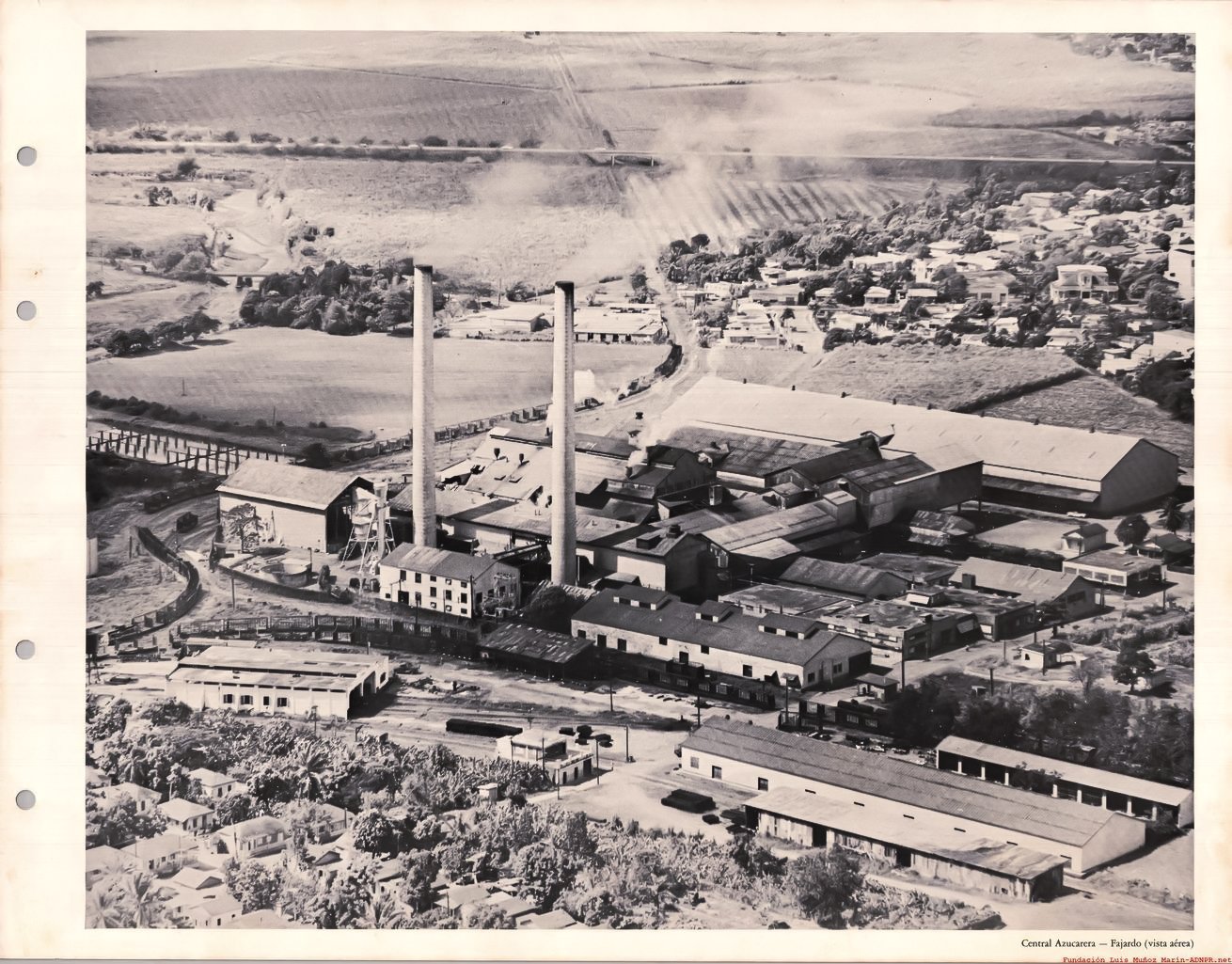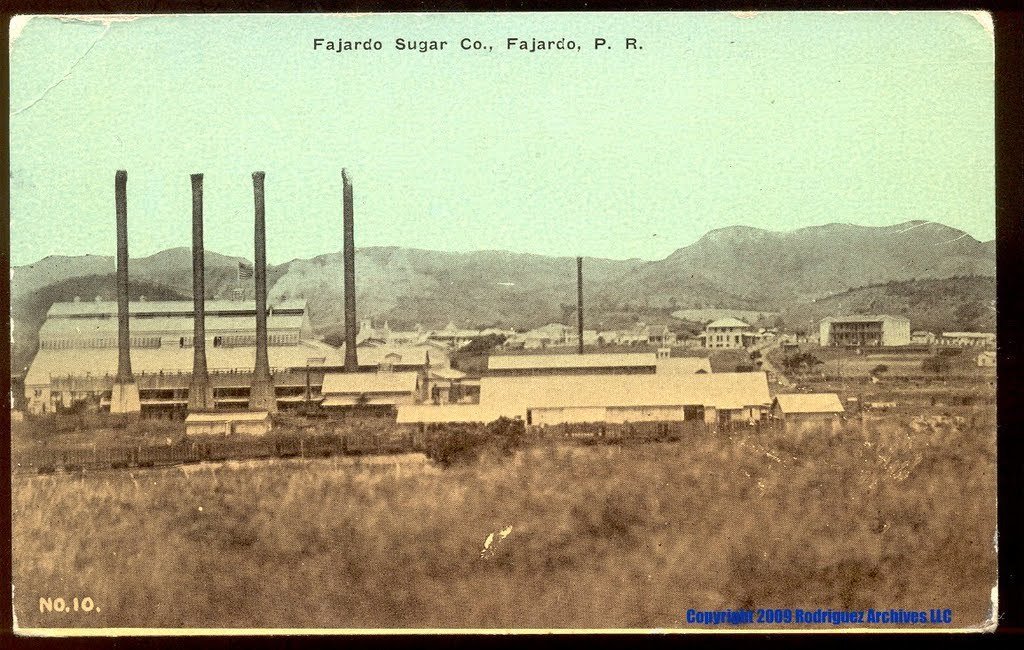
Central Fajardo
Location: Fajardo
Date Established: 1905
Date Ceased Operations: 1977
Annual Production Graph
Average Annual Production: 44,244 Tons
Best Production Year: 1934/86,398 Tons
Family Ownership: N/A
Corporate Ownership: Fajardo Sugar Company, Fajardo Sugar Comany of PR, Fajardo Eastern Sugar Association, C. Brewer, PR, Inc.
The first promoters of a central sugar mill in the Fajardo area were Jorge Bird Arias (1868-1950) and his father Naguabo born Jorge Bird León (1828-1911), son of Irish immigrant George Bird Bowman (1789-1836), an and Belén León Cabaniz (1807-1883) a Venezuelan immigrant. The Bird León family moved to Fajardo ca. 1870 where they established trading and maritime businesses transporting sugar between Vieques and several ports in Puerto Rico between Naguabo and Arroyo. He became the major source of crop financing for local hacendados.
Along the way, Bird León acquired farm land either by purchase or foreclosure. He owned the 477 cuerdas Hacienda Tolonesa in Ceiba and the 300 cuerdas Hacienda Carmelita. By virtue of the loan agrrements on the crop financing transactions he made, he controlled and benefited from trading the sugar and molasses produced by his clients. Since an early age, Bird Arias was involved in his father's business becoming manager of the firm Jorge Bird León & Co. while at the same time going into an agricultural equipment sale business with his brother-in-law Antonio R Barceló.
In 1902 Bird León and Bird Arias met with a group of the Fajardo area sugar plantation owners, most of them indebted to their firm, and pitched the idea of establishing a central sugar mill. All of them agreed to the idea and pledged to have sugarcane grown in their estates, which totaled in excess of 2,000 cuerdas, to be processed at the new sugar mill. They empowered Bird Arias to pursue the concept but even though they had the interest of an English company to build the factory, probably the Colonial Co., the idea never came to fruition.
Bird Arias studied at Russell Military Academy in New Haven, CT where one of his fellow students was Charles P. Armstrong. Armstrong would later become president of the firm L. W. & P. Armstrong, a large sugar broker in New York City. While on a business trip to New York in 1903, Bird Arias met with Armstrong and mentioned the benefits of establishing a sugar mill in Fajardo, this was the genesis of Central Fajardo.
The Fajardo Sugar Co. was incorporated in New York City in March 1905 by Lorenzo D. Armstrong, Atty. James Bliss Coombs (1865-1933), Henry R. Conger and Jorge Bird Arias (1868-1958). It was the first of only three central sugar mills on the island combining US and puertorican capital and top management, the other two being Central Rochelaise and Central Juncos. Its first grinding season was 1907-1908 when it produced 9,687 mt of raw sugar or 4.36% of the isalnd's total production that year.
Bliss Combs who acted as President, was an attorney with the New York City firm Armstrong & Keith, he was also treasurer of West India Sugar Finance Corporation (see Central Carmen) and an officer at L. W. & P. Armstrong, Inc., a New York sugar brokerage firm who handled all the sugar produced at Central Fajardo. Lorenzo D. Armstrong had previous experience on the island. His first investment in a sugar mill in Puerto Rico was Central Progreso in Carolina together with Frederick Barnes. Armstrong, also an attorney at Armstrong & Keith, was Director at the Cuban American Sugar Co. where Henry Havemeyer of the American Sugar Refining Co. was also a director.
The Fajardo Sugar Co. had two wholly owned subsidiaries, the Fajardo Sugar Growers Association which owned some 15,000 acres of land and controlled an additional 12,000 or so under long term leases, and the Fajardo Development Co. which built and operated about eighty miles of railroad and a telephone line.
Throughout the years the Fajardo Sugar Co. grew by acquiring land and machinery from defunct sugar mills. After a big labor strike in 1915, Jorge Bird Arias brother Enrique, acquired Central Esperanza in Vieques from Victor Mouraille's son Gustave Mouraille Longpré. After Enrique's death on March 4, 1919, all the assets and rights of the Esperanza Central Sugar Co. were sold at public auction by the marshall of the US District Court for PR to the Colonial Sugar Company as a result of a suit filed by L. W. & P. Armstrong for an unpaid mortgage of $1,730,000. On November 17,1929 the Colonial Sugar Company transferred and conveyed all its assets and rights to the Fajardo Sugar Co. who then sold it to the United Porto Rican Sugar Co. In 1915 the Fajardo Sugar Co. acquired at public auction all the assets of the Naguabo Sugar Co. which operated Central San Cristobal in Naguabo. In 1930 the Fajardo Sugar Co. of Porto Rico acquired the assets of Central Triunfo in Naguabo and in 1931 those of Central San Miguel in Luquillo.
The Fajardo Sugar Co. of Porto Rico was incorporated in February 28, 1919 to take over all the assets and liabilities of the Fajardo Sugar Co. It had controlling interest over the Fajardo Sugar Grower's Association. Officers of the Fajardo Sugar Company of Porto Rico were James Bliss Combs, President; Albert Bunker, Loring N. Farnum and Lorenzo D. Armstong, Vicepresidents; Lorenzo's brother Frederick S. Armstrong, Secretary/Treasurer and John B. Warrock, Assistant Secretary/Treasurer. Additional members of the Board of Directors were Thomas Andrews Howell and his cousin James Howell Post, George R. Bunker, Edwin Packard, Jorge Bird Arias and Joaquin Casanovas. In December 1933, Austrian born John Bass, an officer at L. W. & P. Armstrong since 1914 was elected President of the Fajardo Sugar Co. as per this 1938 Proudfoot's Commercial Agency report to Lazard Freres & Co.
Central Fajardo was built by Samuel Vickess, the same engineer that built Central Chaparra in Cuba. Both the Chaparra and Fajardo sugar mills were controlled by B. H. Howell, Son & Co. and the National Sugar Refining Co. of NJ. James Howell Post, who was Director of the National City Bank and Thomas B. Howell, were also directors of Fajardo as well as of Central Aguirre.
Central Fajardo was the third sugar mill established with US capital after the Guanica Centrale and Central Aguirre and as stated above, the first with combined US-Puerto Rican participation in capital and management. The Puerto Rican participation increased over the years as can be seen in the 1950 Annual Report to Stcockholders. Throughout the years, four US corporations owned or controlled multiple sugar mills; Fajardo Sugar Corporation, Aguirre Sugar Company, South Porto Rico Sugar Company and United Porto Rican Sugar Co. The Fajardo Sugar Corp. owned Central Fajardo and Central Canovanas in the nearby town of Loiza. It was one of the largest sugar mills on the island.
On January 26, 1936 The New York Times reported that "Attorney General Benigno Fernandez Garcia has started proceedings in the Supreme Court of Puerto Rico seeking to dissolve the fajardo Sugar Company of Puerto Rico, the Fajardo Sugar Growers Association and the Loiza Sugar Company, purchased in 1925 by the Fajardo Company... The petition asks for the dissolution of the three concerns, cancellation of their corporate franchises and prohibition against their doing business in the island. The government alleges the companies own and control more than 30,000 acres."
In 1945 the Board of Directors of the Fajardo Sugar Co. approved a consent decree under which the company would extend a three year option to the Land Authority of Puerto Rico to purchase its agricultural lands. The lands in question were owned by the Fajardo Sugar Growers Assoc. which would then be liquidated. The Land Authority exercised the option in 1947 which transaction netted the Fajardo Sugar Co. $1,229,430 in profits.
In 1958 the Fajardo Sugar Co. of PR, merged with Eastern Sugar Associates the succesor to the United Porto Rican Sugar Co. The merger transaction called for all the assets and liabilities of the Fajardo Sugar Co. of PR to be exchanged for shares of a new corporation to be called Fajardo Eastern Sugar Associates. The merger came as a suprise as the only remaining assets of the Fajardo Sugar Co. of PR were its two sugar mills as its lands had been expropriated by the Government as a result of the implementation of the 500 Acre law. The new venture did not last long and in 1961 Fajardo Eastern Sugar Associates was aquired by C. Brewer Puerto Rico, Inc., a subsidiary of C. Brewer & Co. of Hawaii.
C. Brewer Puerto Rico, Inc. was not successfull and lasted only six years in operation. In her book Santa Juana y Mano Manca, Ivonne Acosta states that when C. Brewer Puerto Rico, Inc. announced in 1966 it was ceasing operations in Puerto Rico, only two of the five sugar mills originally acquired were in operation, Central Fajardo and Central Juncos. Central Defensa and Central Pasto Viejo had shut down in 1939 and 1959 respectively, Central Cayey shut down after the 1966-67 grinding season, Central Canovanas had shut down in 1965 and Central Santa Juana shut down in 1967. The government of Puerto Rico continued to operate the Fajardo sugar mill until it finally closed down in 1995.
The sugar mill built a number of houses for its workers or "batey". Today, these comprise the area knownas "Barrio Jerusalén" adjacent to the sugar mill remains. Most of the original houses have been remodeled and improved and are currently occupied. One of the pictures below is the structure of an abandoned house which, as stated by a neighbor, is the never altered original design.
The sugar mill's location is now right in the middle of town, adjacent to the Superior Courthouse Building. In 2011 the government sold its machinery in Honduras and whatever remained was sold as scrap.





